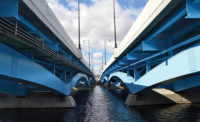ENR 2024 New York Best Projects
Best Project Highway/Bridge: Replacement of Tower Elevators and Rehab at Marine Parkway-Gil Hodges Memorial Bridge (MP-09)

Photo courtesy Kiewit Infrastructure Co.
Replacement of Tower Elevators and Miscellaneous Rehabilitation at the Marine Parkway-Gil Hodges Memorial Bridge
Brooklyn. N.Y.
BEST PROJECT
Submitted by: Kiewit Infrastructure Co.
Owner: MTA Capital Construction and Development Co.
Lead Design: Kiewit Engineering (NY) Corp.
General Contractor: Kiewit Infrastructure Co.
Structural Engineer & MEP Engineer: WJE Engineers & Architects P.C.
Architect: Sowinski Sullivan Architects
MPT Designer: Matrix New World Engineering
Working under a design-build delivery contract, the team completed replacement of two tower elevator systems on the Marine Parkway–Gil Hodges Memorial Bridge, a 540-ft-long vertical lift span oened in 1937, and rehabilitated mechanical components, including the span locks. Crews also rehabbed barrier gates and auxiliary counterweights to reduce maintenance needs.
The maintenance team was particularly concerned that the two tower elevators rarely functioned. The north tower elevator did not work, and the south tower elevator functioned only immediately after the Metropolitan Transportation Authority maintenance contractor would troubleshoot it.
To conduct routine maintenance, personnel were forced to climb as many as seven different open-air ladders 120 ft above an active roadway with heavy tools and materials.
Kiewit furnished and installed new elevators that could withstand harsh conditions and built a protective enclosure system that will extend the elevators’ service life.

Photo courtesy Kiewit Infrastructure Co.
The existing span locks—which assure the middle span stays in the closed position and prevents unwanted, unnecessary or accidental lifting—also required near-constant maintenance. The team rehabbed and upgraded them to boost reliability.
A major project challenge was providing safe access to work areas and bringing materials and tools to installation points without affecting marine or vehicle traffic.
For the span lock replacement, the team could not cut a hole through the existing bridge grid deck to bring in the assembly mechanism. Instead, it chose to rig the span locks off the side of the bridge, pulling them up the side.
After decades of corrosion and decay, elevator shafts in both towers had an irregular lean. MTA asked for the largest elevators that could physically fit in the shafts.
The team had to overcome shaft leans to provide necessary clearance requirements. It mitigated those risks by taking a LiDAR scan during design, overlaying the elevator into the scan, conducting field surveys and measuring to assure that elevator equipment would fit in shafts with proper clearance.

Photo courtesy Kiewit Infrastructure Co.
In early 2023, the elevator subcontractor was falling behind schedule, putting the anticipated completion date at risk. The team brainstormed ways to shorten installation time for the second tower elevator, monitoring daily installation progress and communicating findings. The subcontractor also worked expanded hours.
Kiewit offered additional craftworkers and gave the subcontractor additional equipment to expedite work. A night shift was able to take advantage of lower winds for eight weeks to install elevator-related steel. As a result, the South Tower elevator installation finished in 107 days—46 days faster than for the North Tower.
The $18.3-million project was completed on schedule and on budget in March 2024, in time for boaters and beach users to have full access to Jamaica Bay. The bridge connects thousands of visitors to beaches and parklands, generating a 50% traffic increase each summer.
“The team exceeded our expectations, showcasing a level of expertise that is truly commendable,” says Sam Tabikh, project CEO at MTA Capital Construction and Development Co.



